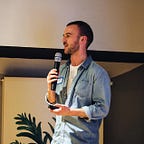Reinventing Product Discovery at the Financial Times
Wait, wasn’t I doing product discovery already?
Well, kinda. Let’s illustrate how we might have approached this before:
- User research helps us uncover an unmet need in business travel
- We prototype a digital travel guide and test this with users — they like it
- Following user feedback, we build the guides
- Our goal is to grow habit — readers coming back to the guides repeatedly
When we look at the results, we see that 60% of users visit a guide and never do so again.
- We ask ourselves — how can we get users to visit more than once?
- We decide to add a newsletter sign-up option, our hunch is that this will encourage users to come back repeatedly
Does it work? Yes, kinda.
The crucial mistake we made here is in not fully understanding the user problem — why were users not visiting again? Knowing this could have sent us down a completely different path.
Other mistakes we sometimes made were in user testing:
- We’d typically test high fidelity prototypes
- We might only test only one or two
- We’d try and find a ‘winner’
The danger here is that we could narrow down to one solution far too quickly — potentially missing a much bigger opportunity or key piece of insight.
The end result of these mistakes was a tendency to go for the safe and familiar over the bold and uncertain.
Solving our discovery problem by ‘storming’
Recognising that we weren’t doing discovery as effectively as we could, we got together representatives from Product, Research, Design and Engineering to design new ways of doing things. This was a ‘storm’ — 1 week focussed only on this, with a proposal to our leadership team at the end of it.
The key thing here is that we solved it bottom-up, not top-down. Our sponsor from the leadership team, Monica Todd, empowered us to find the solution ourselves.
The output was a framework for discovery and a ‘Discovery Guild’ to support our teams in the process. You can read about how the Guild is bringing about culture-change here.
9 months after we introduced our discovery process, where are we now?
All of our customer facing teams have now adopted this new approach to product development.
- It’s all about the user A greater emphasis on uncovering the problems to solve means that we now understand our users better than ever
- New approaches to design and research We soon learned that our old approaches constrained us creatively — we now actively encourage new ways to ideate, test and validate our solutions
- More ambitious solutions For initiatives like our homepage project, we have seen solutions that are far bolder than what we’d see in the past
- A more open and supportive culture Our Discovery Guild creates a safe space for product-people to share successes, failures and what we’ve learned along the way
Moving from a process to a mindset
Our first iteration of this discovery framework has given us a better understanding of our users, new ways of approaching problems and a shift in our product culture.
That said, there’s always room for improvement — looking back, it’s clear that our process was powerful in creating a cultural shift but is perhaps too heavy for where we want to get to. Our vision for the future is discovery as a mindset, not a process.
This means greater confidence in knowing how to explore and tackle problems. More freedom in determining what approach to take, rather than one set process. More comfort with risk and a greater tendency towards experimentation.
We’d love to hear how you approach discovery in your organisations. We’d be happy to speak to you to share our experiences in more detail.
Please feel free to reach out to me at martin.fallon@ft.com
